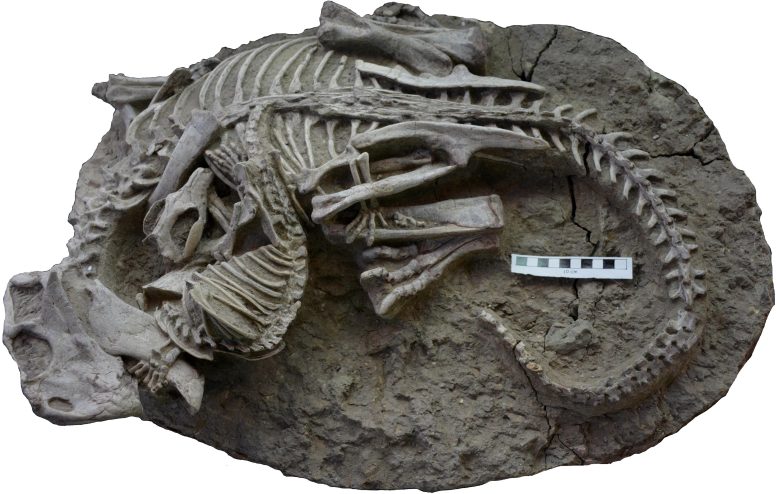
A 125-million-year-old fossil, showing a carnivorous mammal attacking a dinosaur, challenges the long-standing belief that Cretaceous dinosaurs faced minimal threats from mammals. This significant finding offers new insights into prehistoric predator-prey dynamics.
A Glimpse into Prehistoric Predation
Canadian and Chinese scientists have unearthed an unusual fossil, dating back roughly 125 million years, that depicts a carnivorous mammal attacking a larger plant-eating dinosaur. This remarkable find offers a snapshot of a dramatic moment frozen in time.
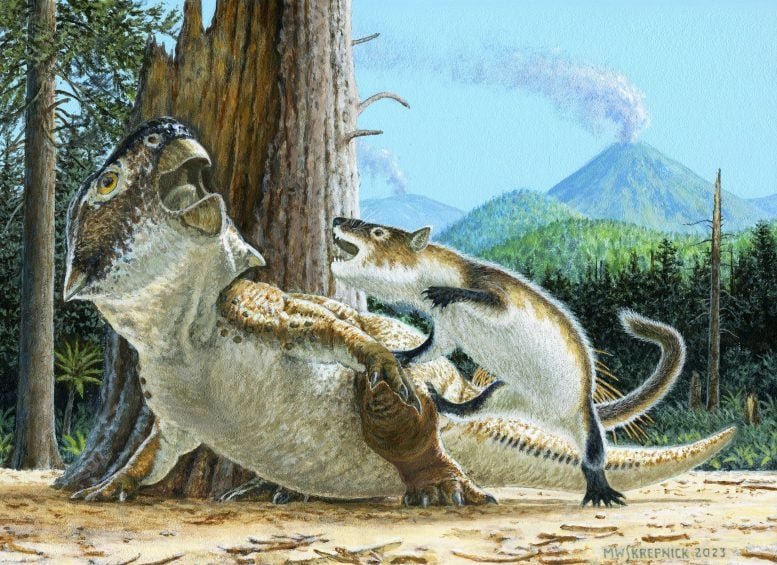
“The two animals are locked in mortal combat, intimately intertwined, and it’s among the first evidence to show actual predatory behavior by a mammal on a dinosaur,” explains Dr. Jordan Mallon, palaeobiologist with the Canadian Museum of Nature and co-author on the study published on July 18 in the journal Scientific Reports.
The fossil’s presence challenges the conventional view that dinosaurs had few threats from their mammal contemporaries during the Cretaceous, when dinosaurs dominated. The unique fossil is now housed in the collections of the Weihai Ziguang Shi Yan School Museum in China’s Shandong Province.
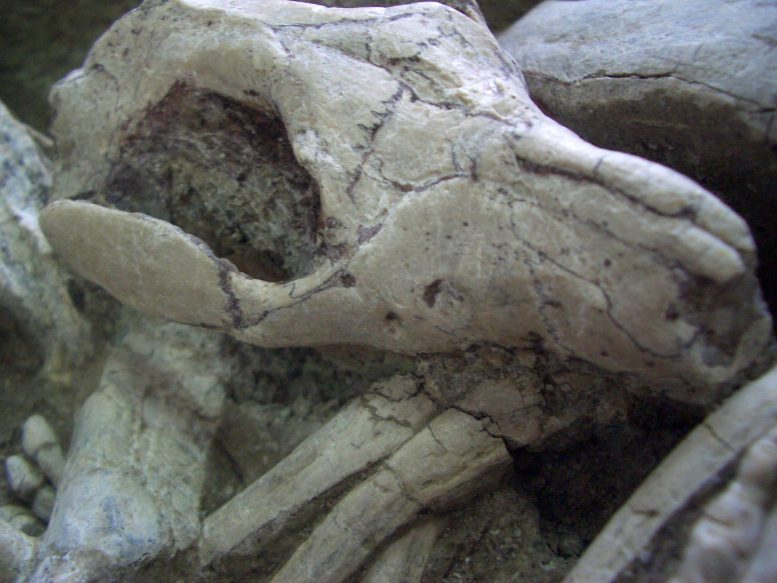
Details of the Fossil Find
The fossil captures a carnivorous, badger-like mammal, called Repenomamus robustus, in the act of attacking a Psittacosaurus, a dinosaur about the size of a large dog. Psittacosaurs, which lived in Asia during the Early Cretaceous period from about 125 to 105 million years ago, are among the earliest known horned dinosaurs. Although not large by dinosaur standards, Repenomamus robustus was one of the biggest mammals of the Cretaceous period—a time when mammals had not yet achieved global dominance.
Prior to this discovery, it was known that Repenomamus preyed on dinosaurs including Psittacosaurus, due to the presence of fossilized baby dinosaur bones found in the mammal’s stomach.
“The co-existence of these two animals is not new, but what’s new to science through this amazing fossil is the predatory behavior it shows,” says Mallon.
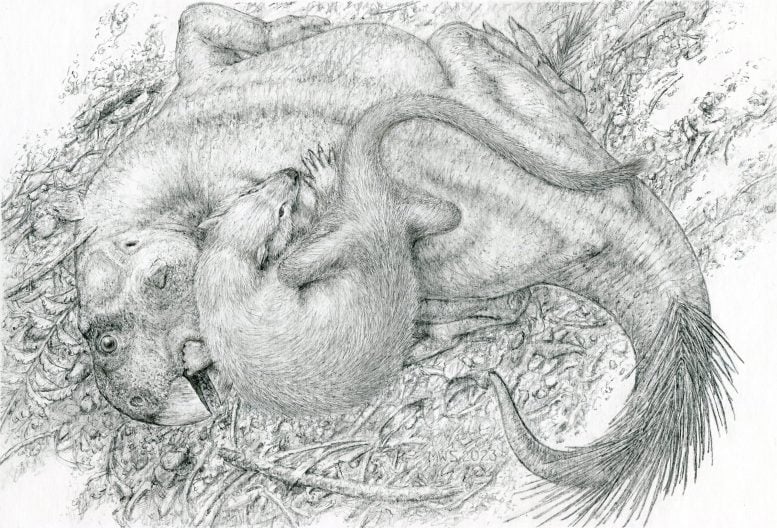
Unearthing the Evidence
The fossil, collected in China’s Liaoning Province in 2012, is remarkably well-preserved with nearly complete skeletons of both animals. This level of preservation is due to its origin in the Liujitun fossil beds, an area aptly dubbed “China’s Dinosaur Pompeii.”
This name references the multitude of preserved fossils of dinosaurs, small mammals, lizards, and amphibians in the area—creatures that were rapidly buried by mudslides and debris from volcanic eruptions. Canadian Museum of Nature mineralogist Dr. Aaron Lussier confirmed the presence of volcanic material in the rock matrix of the fossil under study.
The Psittacosaurus-Repenomamus fossil was in the care of study co-author Dr. Gang Han in China, who brought it to the attention of Canadian Museum of Nature palaeobiologist Xiao-Chun Wu. Dr. Wu has worked with researchers in China for decades and knew it was special when he saw it.

Analysis of the Predation Scene
Upon close examination, the fossil pair shows the Psittacosaurus lying prone, its hindlimbs folded on either side of its body. The Repenomamus is seen coiling to the right and sitting atop its prey, gripping the jaw of the larger dinosaur and biting into its ribs. The mammal’s back foot is also gripping onto the dinosaur’s hind leg. “The weight of the evidence suggests that an active attack was underway,” says Dr. Mallon.
The research team, including Mallon and Wu, dismissed the idea that the mammal was merely scavenging a dead dinosaur. The absence of tooth marks on the dinosaur’s bones, for example, suggests it was not being scavenged, but actively preyed upon. It is unlikely that the two animals would have become so entangled if the dinosaur had already been dead before the mammal found it. The position of the Repenomamus on top of the Psittacosaurus also suggests it was the aggressor.
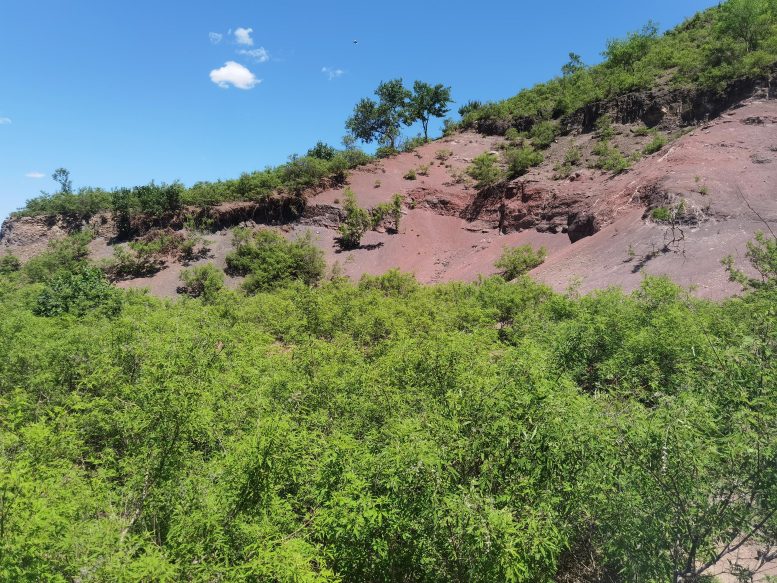
Modern Analogies and Future Discoveries
Similar situations of smaller animals attacking larger prey are observed in the modern world. For instance, lone wolverines are known to hunt larger animals like caribou and domestic sheep. In the African savanna, wild dogs, jackals, and hyenas will attack prey that is still alive, often leaving them in a state of shock.
“This might be the case of what’s depicted in the fossil, with the Repenomamus actually eating the Psittacosaurus while it was still alive—before both were killed in the roily aftermath,” explains Mallon.
The research team anticipates that the volcanically derived deposits from the Lujiatun fossil beds in China will continue to provide fresh evidence of interspecies interactions, hitherto unknown from the fossil record.
Reference: “An extraordinary fossil captures the struggle for existence during the Mesozoic” by Gang Han, Jordan C. Mallon, Aaron J. Lussier, Xiao-Chun Wu, Robert Mitchell and Ling-Ji Li, 18 July 2023, Scientific Reports.
DOI: 10.1038/s41598-023-37545-8
11 Comments
Jaguar prey on the dinosaur spectacled caiman but not the black caiman
On spinosaur report I read it wrong it was not detail but it is detail if you know how .the enigmatic theropod spinosaurus academi edu link the right link is hard to find .they say irritator and spinosaurus spinosaurinae has single horn what does that mean this mean baryonyx has two horn baryonyx has primitive brow horn a common feature in carnosaur that why they thought ceratosaurus is ancestor of tetanuran I do not believe that it’s two advance and primitive.these are horn found in triceratops Cuban crocodile Siamese crocodile and some Nile crocodile these horn are different in modern crocodile it’s a different bone in baryonyx it’s nasolacrimal bone two parasagittal horn for baryonychinae it’s impossible for spinosaurus to have those horn because there eyes are on top of there skull that why modern crocodilian move it to squamosal bone behind the eye .baryonyx is the first mesoeucrocodylia it’s not as advance like spinosaurus it’s did not evolve those aquatic feature like hippo and modern crocodile
Spinosaur and irritator horns or crest are in middle of the skull the 2 nasal attach to cartilage but now it’s occified so cartilage turn into bone the more cartilage occified and turn into horn
Baryonyx has two horn one on top of its eyes there is no horn in the middle I was confuse by the paleo art they had one horn or two horn or two horn 3 d it was hard to see
They use spinosaurus skull to show baryonyx skull because Ct scan came later but baryonyx does not have fuse nasal
Baryonychinae is very different from spinosaurinae .baryonyx eyes are a land animal eyes like most theropod .spinosaurinae eyes is like modern crocodilian
Most tetanuran dinosaur lack osteoderm on the skull common in tyrannosaur .allosaur allso has brow horns maybe it is feature for tyrannosaur .the fuse nasal is found in none tetanuran dinosaur .allosaurus is a tyrannosaur
Dinosaur osteoderm skin is not for thermoregulation because modern dinosaur the gator only subadult and adult have osteoderm
I thought juvenile did not have osteoderm because they are so small likely these are cartilage or fat and are not osteoderm .modern dinosaur gator live in artic weather in North Carolina
The death roll system the osteoderm have nothing to do with death roll system the death roll system test I saw use a juvenile it’s for bipedalism locomotion modern crocodilian has new muscle in the vertebrae allso found in birds but not lizard or tuatara
They say horn of these mesoeucrocodylia voay ceratosuchus looks like pterosaur but pterosaur crest or horn is single horn at the back of the skull the horn of ceratosuchus look like lynx ears .the spectacled caiman horn is 4 horn the horn on spectacled caiman on the eye looks like allosaurus but modern crocodilian does not have land eyes these horn are on eyelid the won on the top skull is more like allosaurus and it’s 2 horn but the horn is not squamosal bone on YouTube brave wilderness dangerous caiman catch .they show the horns the 4 horns even say horns are like allosaurus by the scientist and say lynx horn not found in American alligator .I was watching YouTube crocodile the descendants of dinosaur.and saw dwarf crocodile with lynx horns I never saw that before in modern crocodilian I know was dwarf crocodile by strange teeth and I was right